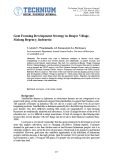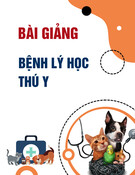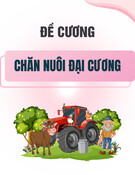
Goat Farming Development Strategy in Benjor Village,
Malang Regency, Indonesia
S. Azizah; U. Wisaptiningsih; A.E. Kusumastuti; J.A. Putritamara
Socio-economics Department, Animal Science Faculty, University of Brawijaya
siti.azizah@ub.ac.id
Abstract. The research aims were to determine strategies in farmers' social capital
strengthening to increase trust between farmers and stakeholders, in market structure, and
technical-social farmers' empowerment. The study was conducted in Benjor Village, Tumpang
District, Malang Regency, and the number of respondents was 30 people. Data analysis methods
used in research are SWOT analysis with IFAS (Internal Strategic Factors Analysis Summary)
and EFAS (External Strategic Factors Analysis Summary) and continued with AHP (Analytic
Hierarchy Process) analysis. The results of the study that the cartesian diagram position of local
goat development in Benjor Village in quadrant IV, which means there are more weak points
than strength points, more threat points than the opportunity points. Therefore, developing the
local goat business needs to change the strategy through strengthening social capital in the trust
of both other farmers with stakeholders.
Keywords. local goats, social capital, strategy
Background
Smallholder farmers in Indonesia as subsistence farmers are not categorized as an
empowered group, so they need much support from stakeholders to support their business scale.
The majority of farmers in Indonesia who are still at a small scale level even do not have
bargaining positions. Smallholders in Indonesia generally have the following characteristics: 1)
poor farmers who have difficulty meeting their needs are marginalized, 2) their farming
businesses are traditionally inherited and subsistence, 3) lack of insight because of the level of
education low, so it is difficult to adopt innovations, 4) lack of courage to take farming risks
because they are not familiar with new things and are at risk to their financial condition (Kay,
2004)
Local goat is a livestock commodity that has great potential to be developed in several
areas that support cultivation, such as Tumpang sub-district, Malang regency. Consumer
demand for goat meat is less than chicken meat or beef because Indonesian people's tret it as
substitute products. Also, given the price of goat meat, which tends to be expensive and limited
availability. However, goat meat can contribute significantly to the fulfilment of Indonesian
people's nutrition because it has high protein. Goat fat content 50-65 percent lower than beef,
and cholesterol is only 5-39 mg per 100 grams. For people who are running a fat diet, goat meat
is better than beef.
217
Technium Social Sciences Journal
Vol. 5, 217-224, March 2020
ISSN: 2668-7798
www.techniumscience.com





















